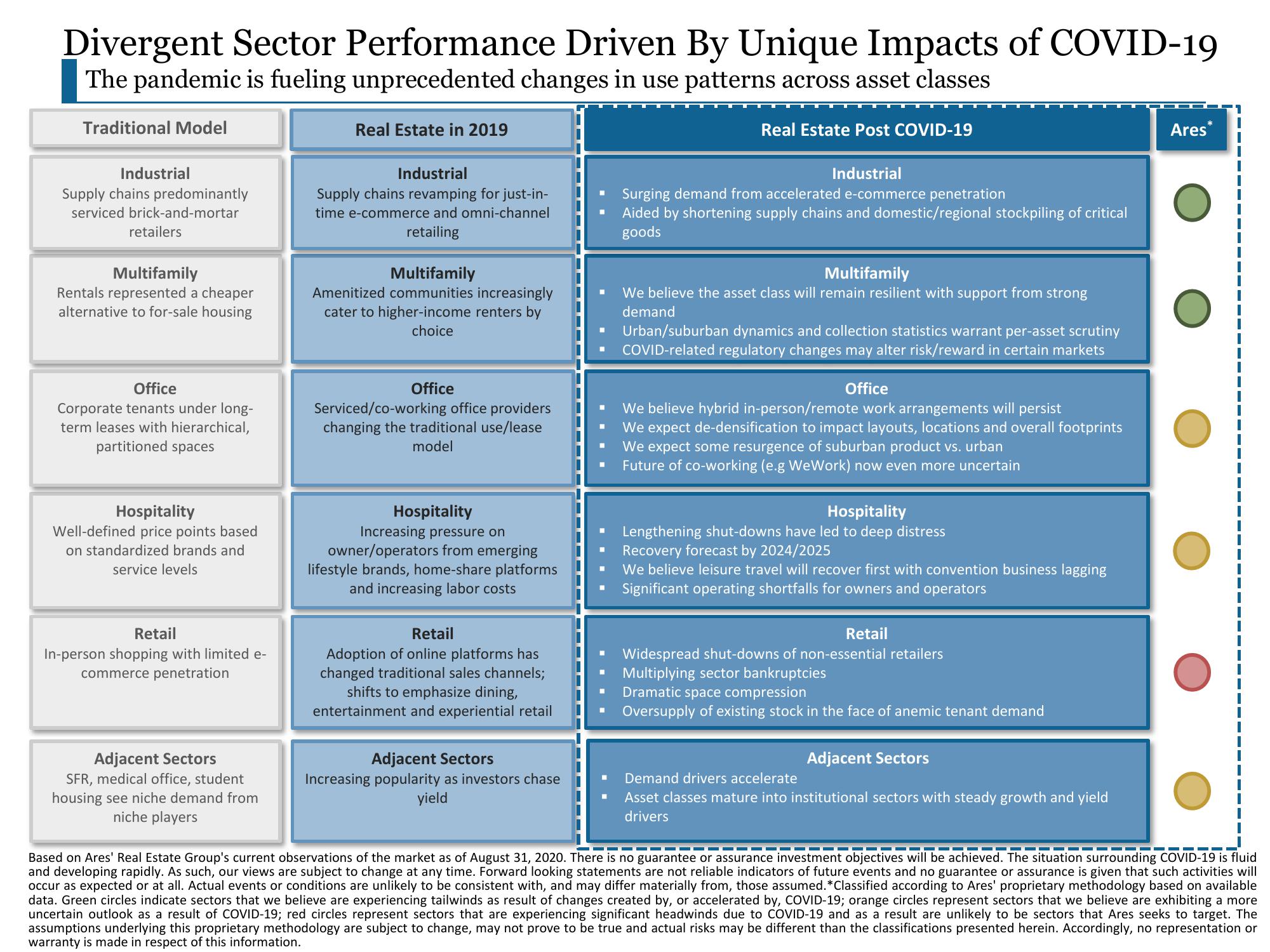Ares US Real Estate Opportunity Fund III
Divergent Sector Performance Driven By Unique Impacts of COVID-19
The pandemic is fueling unprecedented changes in use patterns across asset classes
Traditional Model
Industrial
Supply chains predominantly
serviced brick-and-mortar
retailers
Multifamily
Rentals represented a cheaper
alternative to for-sale housing
Office
Corporate tenants under long-
term leases with hierarchical,
partitioned spaces
Hospitality
Well-defined price points based
on standardized brands and
service levels
Retail
In-person shopping with limited e-
commerce penetration
Adjacent Sectors
SFR, medical office, student
housing see niche demand from
niche players
Real Estate in 2019
Industrial
Supply chains revamping for just-in-
time e-commerce and omni-channel
retailing
Multifamily
Amenitized communities increasingly
cater to higher-income renters by
choice
Office
Serviced/co-working office providers
changing the traditional use/lease
model
Hospitality
Increasing pressure on
owner/operators from emerging
lifestyle brands, home-share platforms
and increasing labor costs
Retail
Adoption of online platforms has
changed traditional sales channels;
shifts to emphasize dining,
entertainment and experiential retail
Adjacent Sectors
Increasing popularity as investors chase
yield
Industrial
■ Surging demand from accelerated e-commerce penetration
Aided by shortening supply chains and domestic/regional stockpiling of critical
goods
"
■
■
■
M
■
■
Real Estate Post COVID-19
■
Multifamily
We believe the asset class will remain resilient with support from strong
demand
Urban/suburban dynamics and collection statistics warrant per-asset scrutiny
COVID-related regulatory changes may alter risk/reward in certain markets
Office
We believe hybrid in-person/remote work arrangements will persist
We expect de-densification to impact layouts, locations and overall footprints
We expect some resurgence of suburban product vs. urban
Future of co-working (e.g WeWork) now even more uncertain
Hospitality
Lengthening shut-downs have led to deep distress
Recovery forecast by 2024/2025
We believe leisure travel will recover first with convention business lagging
Significant operating shortfalls for owners and operators
Retail
Widespread shut-downs of non-essential retailers
Multiplying sector bankruptcies
■ Dramatic space compression
Oversupply of existing stock in the face of anemic tenant demand
Adjacent Sectors
Demand drivers accelerate
Asset classes mature into institutional sectors with steady growth and yield
drivers
Ares
Based on Ares' Real Estate Group's current observations of the market as of August 31, 2020. There is no guarantee or assurance investment objectives will be achieved. The situation surrounding COVID-19 is fluid
and developing rapidly. As such, our views are subject to change at any time. Forward looking statements are not reliable indicators of future events and no guarantee or assurance is given that such activities will
occur as expected or at all. Actual events or conditions are unlikely to be consistent with, and may differ materially from, those assumed.*Classified according to Ares' proprietary methodology based on available
data. Green circles indicate sectors that we believe are experiencing tailwinds as result of changes created by, or accelerated by, COVID-19; orange circles represent sectors that we believe are exhibiting a more
uncertain outlook as a result of COVID-19; red circles represent sectors that are experiencing significant headwinds due to COVID-19 and as a result are unlikely to be sectors that Ares seeks to target. The
assumptions underlying this proprietary methodology are subject to change, may not prove to be true and actual risks may be different than the classifications presented herein. Accordingly, no representation or
warranty is made in respect of this information.View entire presentation